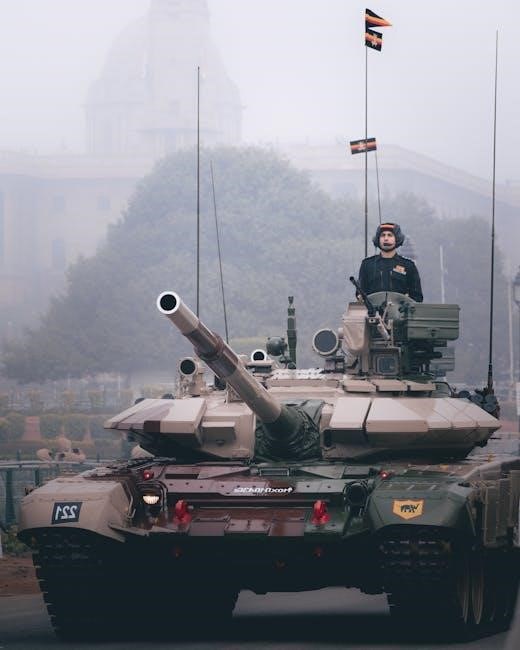Urban warfare presents unique challenges for tank operations, requiring specialized tactics to navigate confined spaces, mitigate anti-tank threats, and coordinate with infantry for mission success.
Overview of Urban Warfare Challenges
Urban warfare is one of the most challenging environments for military operations, particularly for tanks. The densely populated terrain, narrow streets, and high-rise buildings create a three-dimensional battlefield, complicating mobility and visibility. Tanks face heightened risks from anti-tank weapons, ambushes, and improvised explosive devices. Additionally, the confined spaces negate traditional advantages of armor and firepower, while the proximity of civilians and infrastructure increases the complexity of operations. These factors demand specialized tactics and coordinated efforts to mitigate risks and achieve objectives effectively.
Importance of Tank Tactics in Urban Environments
Tank tactics are crucial in urban warfare due to the unique challenges posed by densely populated areas. Tanks provide significant firepower and mobility, enabling forces to breach defenses and secure key positions. However, their effectiveness hinges on carefully coordinated tactics to mitigate vulnerabilities. Trained crews must balance offensive capabilities with defensive measures, leveraging cover and concealment. The integration of tanks with infantry and other assets ensures urban operations are executed with precision, minimizing risks while maximizing impact in high-stakes environments.
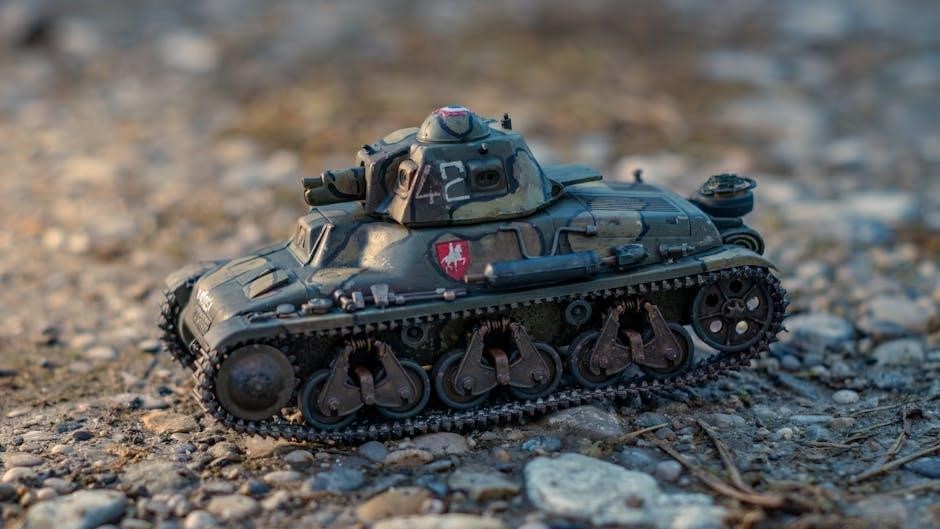
Historical Context and Key Battles
Stalingrad and Aleppo highlight the challenges of urban tank warfare, where confined spaces and ambush tactics negate traditional armored advantages, shaping modern strategies for urban combat.
Lessons Learned from Stalingrad and Aleppo
Stalingrad and Aleppo underscore the challenges of urban tank warfare, where dense environments negate traditional advantages of armor. In Stalingrad, Soviet forces effectively used combined arms tactics, leveraging infantry-tank coordination to counter German armor in narrow streets. Similarly, Aleppo highlighted the vulnerability of tanks to anti-tank missiles and the importance of adaptability. These battles emphasize the need for coordinated fire support, concealment tactics, and infantry protection to mitigate risks in urban combat zones.
Chechen Conflicts and Urban Tank Operations
The Chechen conflicts revealed critical vulnerabilities in urban tank operations, particularly the effectiveness of anti-tank missiles and improvised explosive devices. Russian forces faced significant challenges due to limited visibility, ambushes, and the urban terrain’s restrictive nature. These conflicts highlighted the necessity of enhanced armor protection, improved coordination with infantry, and the use of suppressive fire to minimize risks. Lessons learned emphasized the importance of adaptability and combined arms tactics in mitigating urban warfare challenges for armored units.
Key Challenges for Tanks in Urban Warfare
Urban environments restrict tank mobility, limit visibility, and expose them to anti-tank weapons. The three-dimensional combat complexity increases vulnerability, making adaptation crucial for survival and effectiveness.
Vulnerability to Anti-Tank Weapons
Tanks in urban warfare are highly susceptible to anti-tank weapons, such as portable missile systems and improvised explosives. The close-quarters environment allows enemies to target weak points like top armor and sides. Urban structures provide cover for ambushes, making detection difficult. Additionally, tanks’ limited mobility in narrow streets increases their exposure to such threats. This vulnerability necessitates advanced countermeasures, such as active protection systems and close coordination with infantry to neutralize anti-tank teams effectively.
Restricted Mobility and Visibility
Urban environments severely limit a tank’s mobility and visibility due to narrow streets, tall buildings, and dense infrastructure. This confines movement, making tanks easy targets for ambushes. Restricted sightlines hinder the effective use of main armaments, while multi-story structures enable enemies to attack from elevated positions. Such constraints force tanks to rely on infantry for spotting threats and navigating terrain, emphasizing the need for coordinated tactics to overcome these inherent urban warfare challenges.
Three-Dimensional Warfare Complexity
Urban warfare introduces a three-dimensional battlefield, complicating tank operations. Enemies can attack from rooftops, basements, or elevated positions, exploiting blind spots in tank defenses. This multi-layered environment forces crews to adapt tactics, engaging threats from unexpected angles. Traditional open-field strategies are less effective, as vertical and horizontal obstacles disrupt line-of-sight and mobility. This complexity demands advanced situational awareness and coordinated tactics to counter attacks from all directions, adding a critical layer of difficulty to urban tank operations.
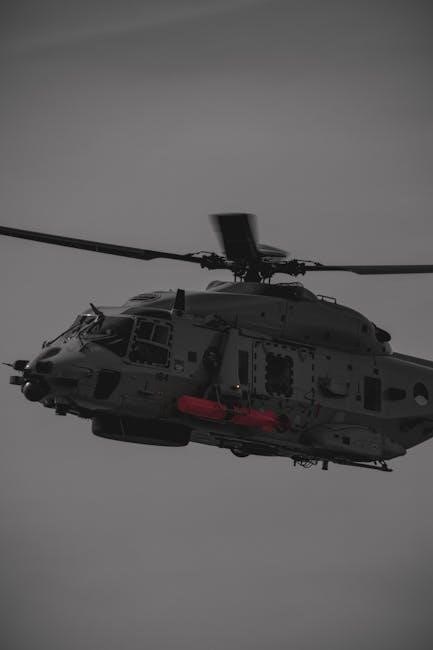
Armor and Protection in Urban Tanks
Urban tanks rely heavily on advanced armor to withstand close-range anti-tank threats, with reactive armor and composite materials enhancing survivability in densely populated combat zones.
The Role of Armor in Close-Range Combat
In urban warfare, armor plays a critical role in protecting tanks during close-quarters engagements. The confined environment often forces tanks into vulnerable positions, where anti-tank weapons can exploit weaker areas like side and top armor. Modern tanks employ composite armor and reactive armor systems to mitigate these threats, ensuring survivability against rocket-propelled grenades and other handheld anti-tank weapons. This layered defense is essential for maintaining operational effectiveness in high-risk urban combat scenarios.
Countermeasures Against Anti-Tank Threats
In urban warfare, tanks employ advanced countermeasures to neutralize anti-tank threats. Active Protection Systems (APS) detect and intercept incoming projectiles, while reactive armor disrupts explosions. Smoke screens are used to obscure visibility, allowing tanks to reposition or escape ambushes. Additionally, coordination with infantry ensures the identification and elimination of hidden threats, enhancing overall survivability in high-risk environments.
Combined Arms Operations
Combined arms operations integrate tanks with infantry, ensuring mutual support and maximizing tactical effectiveness. Coordination of fire and movement enhances mission success while minimizing casualties and collateral damage.
Coordination Between Tanks and Infantry
Effective coordination between tanks and infantry is crucial in urban warfare. Tanks provide suppressive fire and breach strongpoints, while infantry offers close protection and clears buildings. This mutual support enhances mission success, reduces vulnerabilities, and ensures sustained momentum. Real-time communication and precise timing are essential for seamless operations. Such combined arms tactics minimize risks and maximize the lethality of urban combat teams, ensuring they can overcome the dense and unpredictable battlefield conditions of modern city warfare.
Fire Support and Mobility Tactics
Fire support and mobility are critical in urban tank tactics. Tanks use suppressive fire to pin down enemies, while rapid repositioning maintains tactical advantage. Mobility tactics, like flanking maneuvers, exploit urban cover to outmaneuver foes. Fire support from other assets, such as artillery or airpower, complements tank operations, enabling them to breach defenses or isolate enemy positions. Effective integration of firepower and movement ensures tanks remain decisive in the confined, unpredictable urban battlefield, despite inherent vulnerabilities to anti-tank systems and ambushes.
Tactical Techniques for Urban Terrain
Urban terrain requires adaptive tactics, such as sidescraping and concealment, to mitigate vulnerabilities. Tanks maneuver tightly, using buildings for cover, while smoke and obscurants mask movements, enhancing survivability.
Sidescraping and Concealment Tactics
Sidescraping involves maneuvering tanks against obstacles or buildings to shield vulnerable areas. Concealment tactics exploit urban structures to hide from enemy fire, reducing exposure. These methods enhance survivability in dense environments, where anti-tank threats loom. Effective use of cover allows tanks to maintain offensive capabilities while minimizing risks. Proper execution requires precise crew coordination and situational awareness, ensuring tanks remain combat-effective in urban warfare scenarios.
Use of Smoke and Obscurants
Smoke and obscurants are critical in urban warfare to mask tank movements, disrupt enemy targeting, and create temporary cover. These tools enable tanks to escape ambushes, reposition, or protect advancing infantry. By obscuring visibility, smoke screens deny anti-tank teams clear shots, enhancing tank survivability. Proper deployment of smoke also supports coordinated maneuvers, allowing combined arms teams to exploit the chaos. This tactic is essential for maintaining operational flexibility in densely populated and contested urban zones.
Technological Advancements in Urban Tank Warfare
Modern anti-tank systems, drones, and night vision enhance urban tank operations, improving survivability and targeting accuracy. Thermal imaging and advanced armor innovations further bolster effectiveness in dense environments;
Modern Anti-Tank Systems and Drones
Modern anti-tank systems and drones have revolutionized urban warfare, enabling precise strikes on armored vehicles. Portable anti-tank complexes and drones exploit vulnerabilities in tank armor, particularly from above. These systems are highly effective in densely populated areas, where traditional armor advantages are diminished. Their deployment has forced tank crews to adapt tactics, relying on cover, active protection systems, and coordinated infantry support to mitigate threats. This technological shift has significantly altered the dynamics of urban tank warfare.
Role of Night Vision and Thermal Imaging
Night vision and thermal imaging technologies are critical in urban tank warfare, enabling crews to operate effectively in low-light conditions. These systems enhance situational awareness, allowing tanks to detect hidden threats like anti-tank teams or drones. Thermal imaging also aids in identifying camouflaged targets and navigating through obscurants such as smoke or fog. By extending operational capabilities into the night, these technologies provide a significant tactical advantage, ensuring tanks remain potent forces in urban environments around the clock.
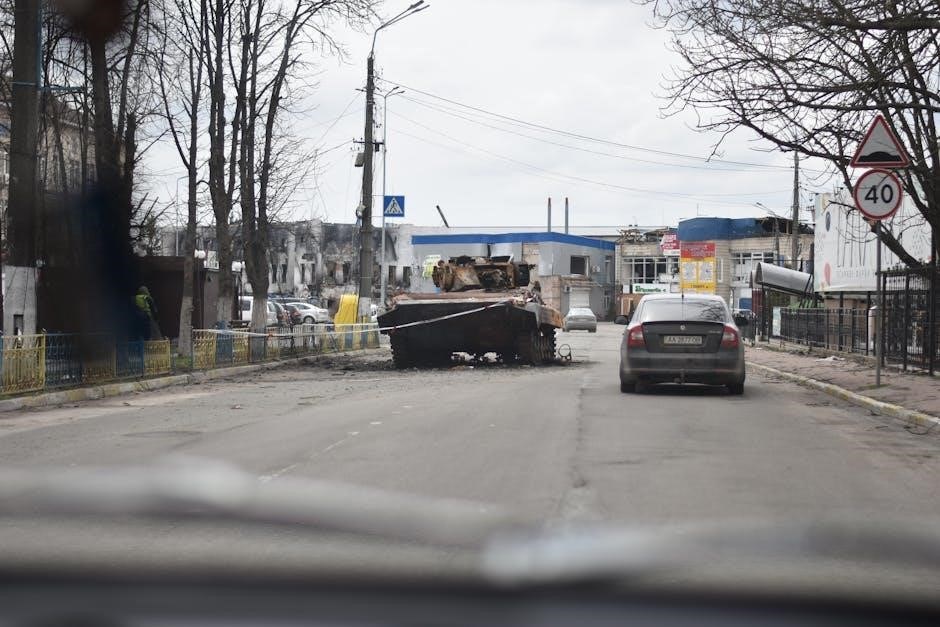
Psychological and Strategic Considerations
Urban warfare strains tank crews mentally, demanding resilience under constant threats. Strategic decisions must balance mission objectives with minimizing collateral damage, ensuring moral standards are upheld amid chaos.
Moral and Psychological Impact on Crews
Urban warfare exposes tank crews to intense psychological stress, with confined spaces, constant threats, and the risk of civilian casualties heightening anxiety and emotional fatigue. The moral burden of potential collateral damage weighs heavily, requiring strong leadership and mental resilience to maintain focus and uphold ethical standards. Training and unit cohesion play a critical role in mitigating these pressures, ensuring crews can perform effectively under extreme conditions.
Minimizing Collateral Damage
Minimizing collateral damage in urban warfare requires precise targeting, advanced systems, and strict adherence to rules of engagement. Tanks must avoid firing on civilian infrastructure, using thermal imaging and night vision to identify non-combatants. Coordination with infantry ensures accurate intelligence, reducing unintended harm. Protocols like limiting high-explosive rounds and using smaller-caliber weapons help mitigate destruction, balancing military objectives with humanitarian concerns in densely populated urban environments.
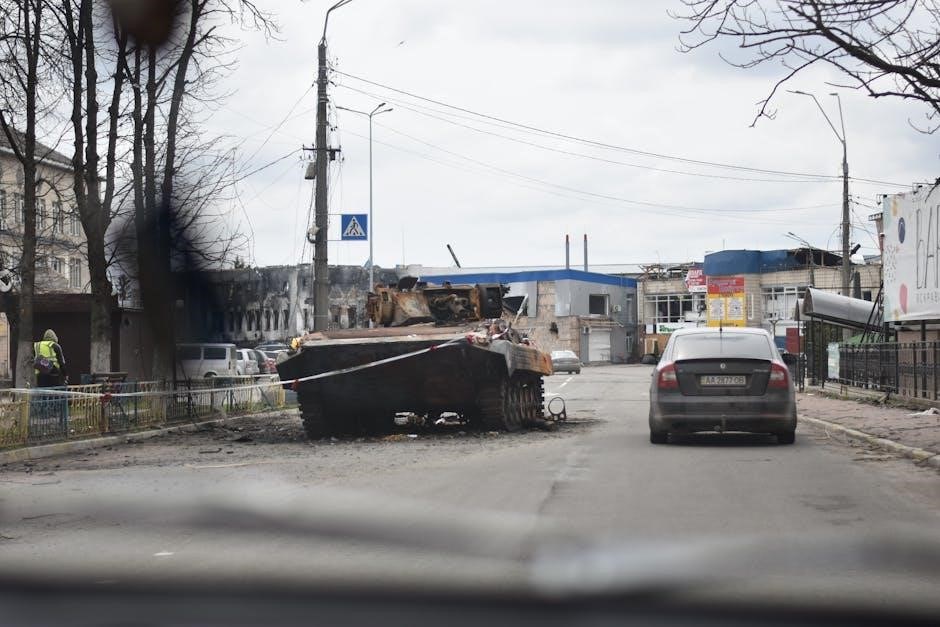
Case Studies and Real-World Applications
Historical battles like Stalingrad and Aleppo highlight the complexities of urban tank warfare, offering lessons on tactics, vulnerabilities, and strategic adaptations in modern conflicts.
Urban Tank Operations in Modern Conflicts
Modern urban conflicts, such as those in Ukraine, highlight the evolving role of tanks in densely populated areas. The use of anti-tank weapons and drones has increased vulnerability, necessitating advanced tactics like sidescraping and smoke screens. Combined arms operations, integrating tanks with infantry and air support, remain critical for success. Urban tank operations now emphasize mobility, concealment, and precision to minimize collateral damage while countering asymmetric threats in complex, three-dimensional environments.
Evolution of Tactics from WWII to Present
Since WWII, urban tank tactics have evolved significantly, adapting to new threats and technologies. Early tactics focused on direct firepower and infantry support, while modern approaches emphasize coordination, stealth, and precision. The integration of night vision, thermal imaging, and drones has transformed urban warfare, enabling tanks to operate more effectively in complex environments. Lessons from conflicts like Stalingrad, Chechnya, and Ukraine have shaped contemporary strategies, prioritizing combined arms operations and minimizing collateral damage in densely populated areas.
